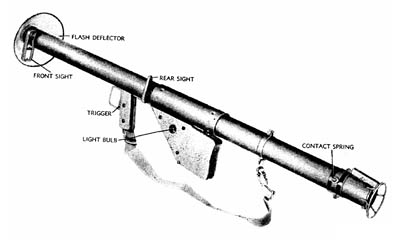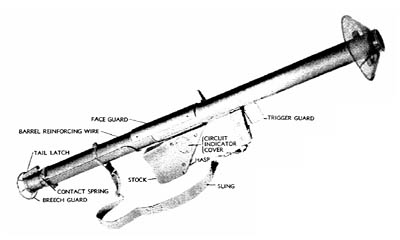Introduction to the “bazooka” (2.36-inch AT Rocket Launcher M1A1) from the technical manual TM 9-294: 2.36-inch A.T. Rocket Launcher M1A1, War Department Technical Manual, September, 1943.
I. INTRODUCTION
1. SCOPE.
a. This manual is published for the information and guidance of personnel charged with the operation and maintenance of the 2.36-inch AT Rocket Launcher M1A1. It contains information required by the using arms to identify, use, care, and preserve the materiel and the ammunition used therewith. In addition, it contains information required by ordnance personnel for the maintenance and repair of the materiel.
2. CHARACTERISTICS (figs. 1 and 2).
a. The 2.36-inch AT Rocket Launcher M1A1 is an electrically operated weapon of the open tube type. It is fired from the shoulder in the standing, kneeling, sitting, or prone positions. It is used to launch high-explosive rockets against tanks, armored vehicles, pill boxes, and emplacements. The rockets weigh approximately 3½ pounds and are capable of penetrating heavy armor at angles of impact up to 30 degrees. The weapon can be aimed up to distances of 300 yards. Greater ranges may be obtained by estimating the angle of elevation. The maximum range is 700 yards.
Figure 1 — 2.36-Inch AT Rocket Launcher M1A1 — Left Side View
Figure 2 — 2.36-Inch AT Rocket Launcher M1A1 — Right Side View
3. DATA.
Length of launcher (approx.) 54.5 in. Weight of launcher (approx.) 13.26 lb Internal diameter 2.37 in. Length of rocket 21.6 in. Weight of rocket 3.5 lb Muzzle velocity 265 ft per sec 4. PRECAUTIONS.
a. Do not expose rockets to the sun except when immediately ready to load. Store rockets in their containers in shaded places.
b. Do not allow a rocket to remain in a hot launcher prior to firing.
c. Rockets as shipped contain a small cardboard plug cemented over the nozzle in the forward end of the fin assembly. This prevents entry of moisture or dirt into the propellent charge during storage and handling. Do not use any rocket with a missing cardboard plug. Do not remove the plug.
d. Since the fuze of the rocket is quite sensitive, it is important that the rocket be handled carefully after removal of the safety pin, and that it not be dropped. A fall on its nose, after removal of the safety wire, will cause detonation.
e. The burning time of the propellant is approximately 0.02 to 0.03 second, and combustion is complete before the rocket leaves the muzzle, hence there is no flash. Occasionally, however, the burning may, for some reason, be retarded, creating a backflash as the rocket leaves the muzzle. This occurs during cold weather but may also occur at other times. The firer should be protected against this by gloves or cloth wrapped around the hands, goggles, or other protective equipment, such as a gas mask. This precaution is especially important in cold climates or when no flash deflector is available. It is also recommended that both the firer and the loader wear steel helmets when using the launcher.
f. The launcher may be fired from the shoulder in the standing, kneeling, sitting, or prone positions. If fired from the prone position, the body should be at an angle of at least 45 degrees to the direction of fire so as to avoid injury from the back blast of the rocket.
g. In using the launcher, it is essential that no personnel, or inflammable material be directly behind the launcher within a distance of 20 feet.
h. Never stand in or near the rear of the launcher while it is being fired because the hot gases can inflict serious burns. When firing from trenches or fox holes, clearance should be provided so that back blast is not deflected against personnel.
i. At temperatures below 14 F, the dry cells become too weak to fire this weapon. When used at low temperatures, batteries should be removed from the launcher and kept warm until just before firing. Carrying the batteries in inner pockets in cold climates will keep them sufficiently warm. The spare batteries can be carried in the pockets and switched with the cold ones every half hour.
j. The rockets should not be fired at temperatures below zero F nor above 120 F











